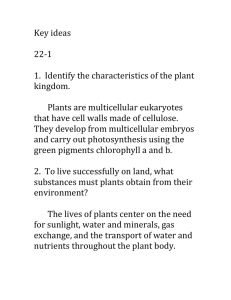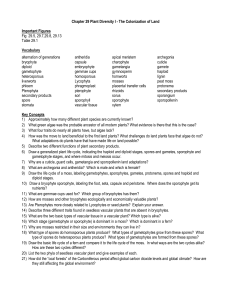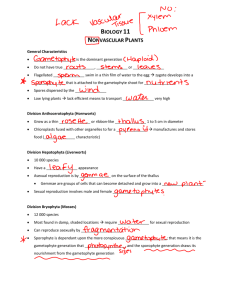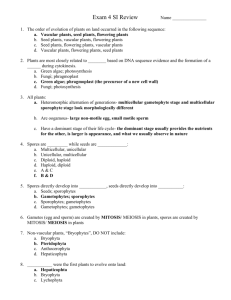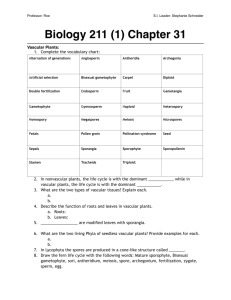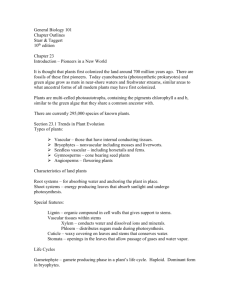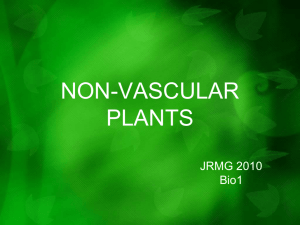exam 4 practice questions
advertisement
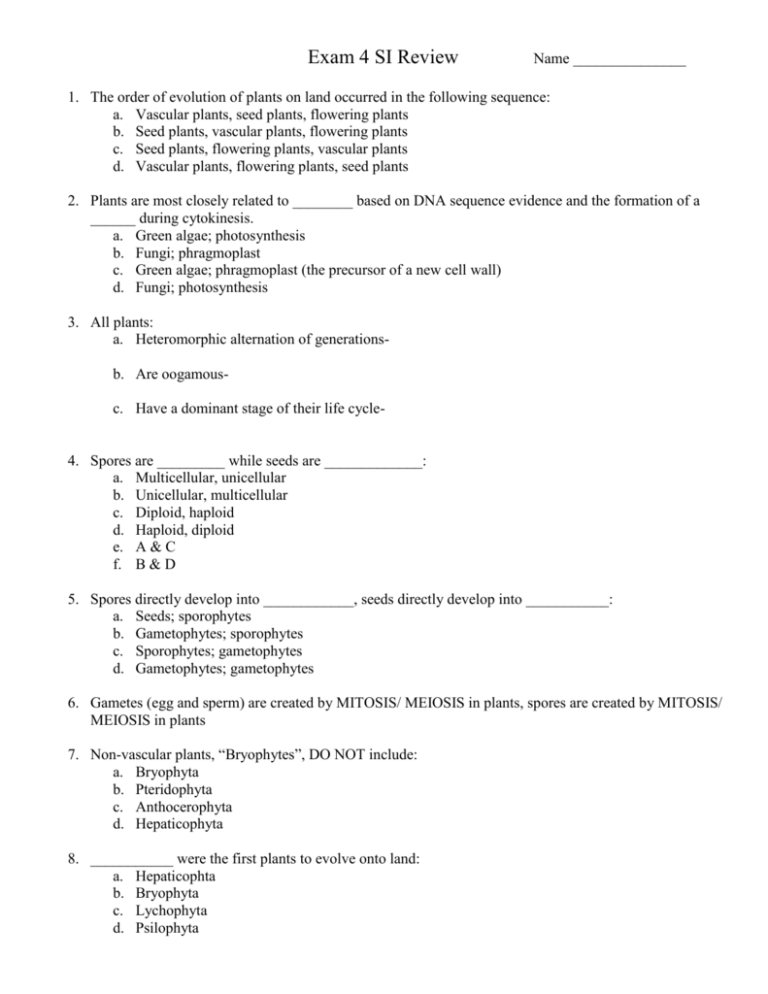
Exam 4 SI Review Name _______________ 1. The order of evolution of plants on land occurred in the following sequence: a. Vascular plants, seed plants, flowering plants b. Seed plants, vascular plants, flowering plants c. Seed plants, flowering plants, vascular plants d. Vascular plants, flowering plants, seed plants 2. Plants are most closely related to ________ based on DNA sequence evidence and the formation of a ______ during cytokinesis. a. Green algae; photosynthesis b. Fungi; phragmoplast c. Green algae; phragmoplast (the precursor of a new cell wall) d. Fungi; photosynthesis 3. All plants: a. Heteromorphic alternation of generationsb. Are oogamousc. Have a dominant stage of their life cycle- 4. Spores are _________ while seeds are _____________: a. Multicellular, unicellular b. Unicellular, multicellular c. Diploid, haploid d. Haploid, diploid e. A & C f. B & D 5. Spores directly develop into ____________, seeds directly develop into ___________: a. Seeds; sporophytes b. Gametophytes; sporophytes c. Sporophytes; gametophytes d. Gametophytes; gametophytes 6. Gametes (egg and sperm) are created by MITOSIS/ MEIOSIS in plants, spores are created by MITOSIS/ MEIOSIS in plants 7. Non-vascular plants, “Bryophytes”, DO NOT include: a. Bryophyta b. Pteridophyta c. Anthocerophyta d. Hepaticophyta 8. ___________ were the first plants to evolve onto land: a. Hepaticophta b. Bryophyta c. Lychophyta d. Psilophyta 9. Which of the following are chemical adaptations to life on land? a. Sporopollenin b. Flavonoids c. Stomata d. All of the above 10. Liverworts, both leafy and thalloid types, utilize gemmae cups for SEXAUL/ ASEXUAL reproduction. Thalloid liverworts have gemmae cups on THE TOP OF THEIR LEAVES/ TIPS OF THEIR LEAVES, while leafy liverworts have gemmae cups on the THE TOP OF THEIR LEAVES/ TIPS OF THEIR LEAVES. 11. Non-vascular plants have a dominant ____________ stage of their life cycle where photosynthesis can be carried out: a. Gametophyte (n) b. Gametophyte (2n) c. Sporophyte (n) d. Sporophyte (2n) 12. All bryophytes have stomata. a. True b. False 13. In non-vascular sexual reproduction, the “seta” acts as a: a. hard outer shell for seed dispersal b. outer covering protecting from UV radiation c. source of nutrients for the embryo d. way for allowing water in and out of the developing embryo 14. Seedless vascular plants EXCLUDE the following: a. Psilophyta b. Pteridophyta c. Equisetophyta d. Cycadophyta 15. The __________ is the dominant stage in all seedless vascular plants. This is __________ to the bryophytes. a. Gametophyte; identical b. Gametophyte; opposite c. Sporophyte; identical d. Sporophyte; opposite 16. Vascular plants have true vascular tissues: a. Phloemb. Xylem- 17. Ferns are heterosporous. a. True b. False 18. Pines and club mosses have a gametophyte stage that is completely DEPENDENT/ INDEPENDENT on its sporophyte stage. 19. Organisms in phylum Lycopoda have a gametophyte stage that may be dependent on a __________ relationship with surrounding fungi. a. Heterosporous b. Homosporous c. Mycorrhizal d. Nutritionally independent 20. Pollen and ovulate cones are considered the _________ of the angiosperm reproductive system. a. Sporophyte stage b. Gametophyte stage c. Pollination stage d. Fertilization stage 21. A mature male Angiosperm gametophyte consists of _____ total cells, while a mature female has _____ total cells with ____ nuclei. 22. Fertilization can occur only after pollination in Angiosperms. a. True b. false 23. A pollen grain is a MATURE/ IMMATURE male GAMETOPHYTE/ SPOROPHYTE. 24. Ovaries are MATURE/ IMMATURE fruits. Fruits are MATURE/ IMMATURE ovaries. 25. Ovules (inside the ovaries) are MATURE/ IMMATURE seeds. Seeds are MATURE/ IMMATURE ovules. 26. While one of the two sperm in a mature gametophyte fertilizes the egg, the other fuses with the ________ to form a triploid cell. This cell within the ovary develops into the _______ for the embryo. a. Egg; endosperm b. Egg; fruit c. Polar nuclei; endosperm d. Polar nuclei; fruit 27. The endosperm derives its nutrients from the parent _________ and stores it as food for the embryo. a. Gametophyte b. Sporophyte c. Egg cells d. Sporangium 28. Why do plants undergo an alternation of generations? 29. Fill out the following chart: Examples Vein Orientation Cotyledon # of Petals eudicots monocots 30. Define the following terms: a. Monoecious: b. Dioecious: c. Perfect flowers: d. Imperfect flowers: 31. Viruses are primarily composed of: a. Cells, nucleic acid, and proteins b. Nucleic acid, proteins, and dsDNA c. Lipids, nucleic acid, and dsDNA d. Nucleic acid, proteins, and lipids 32. Which of the following are immune to being infected by a virus? a. Plants b. Bacteria c. Fungi d. NONE of the above 33. Viruses can only reproduce inside of a living cell. a. True b. False 34. Viruses can have which of the following possible forms of genomic material? a. dsRNA b. ssRNA c. ssDNA d. All of the above are possible Vascular Tissue Arrangement 35. Cellular organisms typically use which of the following forms of genetic material to store their genes in? e. dsDNA f. dsRNA g. ssDNA h. ssRNA Some useful terms to know the differences between in order to make your life a lot easier! Ovule vs ovulate cone vs ovary vs seed Fertilization vs pollination Sperm vs spore vs pollen Gymnosperm vs angiosperm (differences other than “naked seed” and “covered seed”) Phragmoplast Plasmodesmata Seta Archegonia/ antheridum vs archegoniophore/ antheridiophore Integument Tracheid “epiphytes” has to do with ferns “Bryophytes” vs bryophyta lycophytes vs Lycopoda Best of luck!!!
